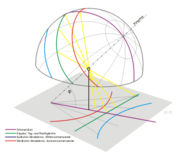Models
Types of Sundials

The accuracy of a sundial is related to the correct position in relation to the axis of the earth and the horizontal level. The sundials have different dials that are either parallel to the horizon, to the equator or to one of the poles.
You can discern the following types, valid for Middle Europe:
Vertical sundial: producing a shadow as long as the sun moves southerly from east to west.
Horizontal sundial: can be read from all directions, the dial lies parallely to the horizon.
Equatorial sundial: gnomon and dial are parallely or in a rectangle position, can be read from all directions.
Polar southern sundial:[nbsp] the shadow moves parallely to the gnomon and to the dial, an exact position to the south is necessary.
Vertical northern sundial: not suitable for Middle Europe, casts only a shadow when the sun appears in the north of the vertical east-west axis.
Polar western sundial: only for displaying in the afternoon, shadow is parallely to the gnomon, dial is directed via west.
Polar eastern sundial: nur für vormittags, Auffallfläche ist nach Osten gerichtet. only for the morning, dial is directed via east
Divergent vertical sundial: when the plain is not correctly directed via south it is necessary to consider this in the construction of the sundial. East divergence: more hours in the morning, west divergence: more hours in the afternoon.
Important: The gnomons of all sundials are always in parallel to the earth axis and directed to the polar star.
You will get the parallel line in raising the gnomon about the angle of the degree of the latitude and directing it to north. (angle=height of the pole Phi)
Phi is consisting of a parallel line between the equatorial level and the zenith. The degree of the latitude, the height of the pole and the angle of Phi are identical.